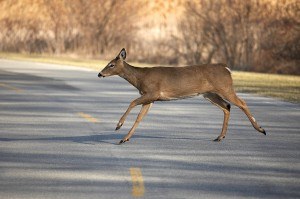Every year in West Virginia, motorists and insurance companies pay more than $50 million to fix damage caused when vehicles collide with deer.
State wildlife and highway officials hope to reduce that total by finding out where collisions most often occur, and by learning how best to prevent them.
“Right now, we’re putting together a request for university research proposals to find out where the collision ‘hot spots’ on our roads are located,” said Chris Ryan, game management services supervisor for the state Division of Natural Resources. “After we identify those locations, we’ll study (accident-prevention) techniques that have worked in other states and try to figure out how to apply them here.”
A $50,000 grant from State Farm Insurance will pay for some of the research. Ryan said the rest of the expense would be split between the DNR and the state Department of Transportation.
“Both of our agencies are interested in trying to reduce the number of deer-vehicle collisions,” he said. “We’ve been working with the folks at DOT for the past several months, exploring research opportunities. We initiated the call (for the study), but DOT will be the agency that actually requests the research proposals.”
During the project’s first phase, researchers will examine deer-mortality data compiled by the DNR and the DOT. For the past several years, workers from both agencies have been recording the locations of deer carcasses found along the state’s highways.
“At DNR, we have a pretty good database already,” Ryan said. “Since 2002, we’ve been taking tissue samples from road-killed deer to check for signs of chronic wasting diseases. We locate each carcass using (the Global Positioning System). We currently have more than 2,500 data sets to work with.
“Highway workers in the Morgantown region have also been logging the locations of carcasses. They use highway distance markers instead of GPS, but their data are still accurate within a couple of hundred feet.”
Researchers will examine the agencies’ databases and decide if the locations could be accurately plotted on Global Information System maps.
“If it can, we’ll use GIS to find where the accident hot spots are. Those locations will tell us where to best apply techniques designed to mitigate the number of accidents,” Ryan said.
The research initially will focus on the state’s four-lane highways, where deer-vehicle collisions tend to occur at high speeds and create more damage. Ryan said both agencies want to focus future collision-prevention efforts on locations where they’re likely to do the most good.
“We feel that the interstates and the Appalachian Corridors are probably where mitigation attempts would be most cost-effective,” he added.
DNR and DOT officials also want researchers to study collision-prevention techniques practiced in other states, and to determine which ones have and haven’t worked.
“We want to use techniques that are proven to work,” Ryan said. “We don’t want to repeat other states’ mistakes. We want to find out which techniques are best and most cost-effective.”
If all goes as planned, the first phase of the study should be complete within a year. Ryan said the study’s second phase would likely attempt to determine which collision-prevention techniques work best along Mountain State roads.
Was this article valuable?
Here are more articles you may enjoy.

 CBS Poised to Lose Bid to Stop Sony Taking ‘Jeopardy’ Rights
CBS Poised to Lose Bid to Stop Sony Taking ‘Jeopardy’ Rights  AI Weather Models Promise Super Granular, Specialist Forecasts
AI Weather Models Promise Super Granular, Specialist Forecasts  Insurance Industry Contemplates Knock-On Effect of Tariffs to Claims, Consumers
Insurance Industry Contemplates Knock-On Effect of Tariffs to Claims, Consumers  Hedge Funds Are Hunting Deals in Risks Too Big for Insurers
Hedge Funds Are Hunting Deals in Risks Too Big for Insurers 